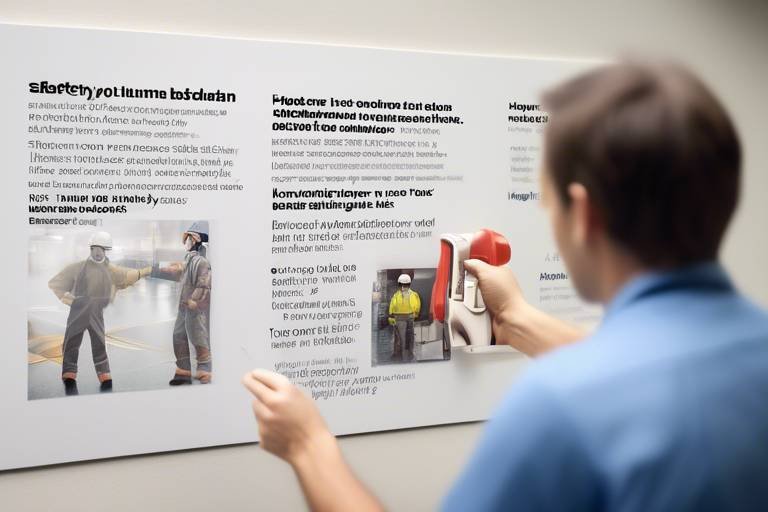Applying The Principles of Human Behavior In Safety Guidelines
In today's world, where safety is paramount in every environment—from workplaces to public spaces—understanding human behavior is essential for creating effective safety protocols. Imagine trying to navigate a maze blindfolded; without a clear understanding of the paths and obstacles, you're likely to run into trouble. Similarly, safety guidelines can often feel like a maze for individuals who are unaware of the underlying principles that govern their behavior. By delving into the intricacies of human psychology, we can enhance these protocols, making them not just rules to follow, but a framework that resonates with our natural inclinations and motivations.
At the heart of this exploration lies the understanding that people are not just robots programmed to follow rules; they are complex beings influenced by a myriad of factors. These include emotions, past experiences, social dynamics, and even cognitive biases. When safety guidelines are designed with these elements in mind, they become more relatable and effective. Think of it like customizing a pair of shoes: a one-size-fits-all approach might work for some, but wouldn’t you prefer a pair that fits your unique foot shape and style? By tailoring safety measures to align with human behavior, we can foster an environment where compliance is not just a chore, but a natural choice.
As we embark on this journey of understanding, we will explore key principles that illuminate the path to better safety practices. We’ll examine the psychological factors that influence our actions, the role of perception in interpreting risks, and how social influences can sway behavior. Each of these elements plays a crucial role in shaping how individuals respond to safety guidelines. The goal is to transform safety from a set of rigid rules into a dynamic process that engages individuals on a deeper level. With this knowledge, we can develop safety protocols that not only protect but also empower individuals to make informed decisions.
When we talk about understanding human behavior in the context of safety, we’re diving into the psychological factors that motivate individuals to comply or resist safety measures. Why do some people follow safety protocols while others disregard them? The answer often lies in a complex interplay of motivations and barriers. For instance, an individual may understand the importance of wearing a helmet while cycling but might choose not to wear one due to a perceived inconvenience or a belief that they are skilled enough to avoid accidents. This highlights the need to address both the motivations and the barriers that influence behavior.
To effectively enhance safety compliance, we must consider various factors, such as:
- Intrinsic Motivation: The internal drive to adhere to safety measures, often rooted in personal values and beliefs.
- Extrinsic Motivation: External factors like rewards or penalties that influence behavior.
- Barriers to Compliance: Obstacles that hinder individuals from following safety protocols, such as lack of knowledge or perceived ineffectiveness of the measures.
By identifying and addressing these factors, organizations can create a more conducive environment for safety compliance, ensuring that individuals not only understand the rules but also feel motivated to follow them.
Perception is a powerful force that shapes how we interpret risks and safety measures. It’s not just about knowing that a certain behavior is safe or unsafe; it’s about how individuals perceive those behaviors in their context. For example, if someone perceives a safety measure as overly complicated, they might ignore it altogether. On the flip side, if they see a clear benefit—like a reduction in accidents—they are more likely to embrace it. This dynamic is crucial in various settings, from industrial workplaces to home environments.
Understanding how individuals assess risks is vital for developing effective safety guidelines. People often rely on cognitive processes that can be influenced by emotions, biases, and past experiences. For instance, someone who has witnessed a workplace accident may become overly cautious, leading them to either adhere strictly to safety protocols or, conversely, become desensitized to risks over time. This highlights the importance of tailoring risk assessments to align with human behavior, ensuring that guidelines are not only informative but also resonate with individuals' lived experiences.
Past experiences shape how individuals respond to safety situations. If someone has had a positive experience with safety measures, they are more likely to comply in the future. Conversely, negative experiences can lead to skepticism or disregard for safety protocols. By understanding this influence, organizations can develop strategies to reinforce positive experiences and mitigate the impact of negative ones.
Social dynamics play a vital role in shaping safety behavior. The influence of peers can either promote adherence to safety guidelines or create a culture of disregard. For instance, if a group of employees consistently ignores safety protocols, new members may feel pressured to conform. Conversely, a strong safety culture can foster a sense of accountability and encourage individuals to prioritize safety. Recognizing these social influences is essential for developing effective safety interventions.
Implementing behavioral interventions can significantly improve safety compliance. Strategies such as positive reinforcement, peer-led training, and engaging communication can motivate individuals to adopt safe behaviors. By creating an environment that encourages safe practices, organizations can enhance overall safety culture.
Proper training and education are essential for instilling safety principles. Effective training methods that incorporate human behavior principles can enhance safety awareness and practices. Engaging individuals in safety training fosters better understanding and retention, ensuring that safety becomes an integral part of their daily routines.
Engaging individuals in safety training can significantly improve retention and compliance. Techniques such as interactive workshops, real-life scenarios, and gamification can make safety training more relatable and enjoyable. When individuals feel involved in the process, they are more likely to internalize the importance of safety.
Feedback mechanisms are crucial for improving safety practices. Continuous feedback allows individuals to adjust their behaviors in real-time, aligning them with safety guidelines. By fostering an open environment where feedback is encouraged, organizations can create a culture of continuous improvement that prioritizes safety.
Q1: Why is understanding human behavior important for safety guidelines?
A1: Understanding human behavior helps tailor safety protocols to align with individuals' motivations and barriers, making compliance more likely.
Q2: How can social influence affect safety behavior?
A2: Social dynamics, such as peer pressure, can either promote adherence to safety guidelines or create a culture of disregard.
Q3: What role does perception play in safety compliance?
A3: Perception shapes how individuals interpret risks and safety measures, influencing their likelihood to comply with safety protocols.

Understanding Human Behavior
When we talk about human behavior, we're diving into a fascinating realm that shapes our everyday actions, especially when it comes to safety. Understanding this behavior is like holding a mirror up to ourselves; it reveals the motivations, fears, and barriers that influence how we respond to safety protocols. Think about it: why do some people always wear their seatbelts, while others might skip it? The answer lies in the intricate web of psychological factors at play.
One of the key elements that influence safety compliance is motivation. Individuals are often driven by various factors, including personal values, perceived risks, and external pressures. For instance, someone who values their health highly might be more inclined to follow safety guidelines than someone who sees them as mere suggestions. On the flip side, barriers such as a lack of awareness, past experiences, or even a dismissive attitude towards risks can hinder compliance. It's essential to recognize these barriers, as they can be the difference between a safe environment and a hazardous one.
Moreover, the social environment plays a significant role in shaping behaviors. People are inherently social beings; we tend to look to our peers for cues on how to act. This can be both a blessing and a curse. For example, in a workplace where safety is prioritized and actively discussed, individuals are likely to adopt similar attitudes and behaviors. Conversely, if the prevailing attitude is one of negligence, even the most safety-conscious individuals might find themselves slipping into risky behaviors. It's a classic case of groupthink, where the desire for harmony or conformity in a group leads to irrational or dysfunctional decision-making.
To truly grasp the dynamics of human behavior in relation to safety, we must also consider the cognitive processes involved in risk assessment. When faced with a potential hazard, individuals engage in a mental evaluation of the situation. They weigh the perceived likelihood of an incident occurring against the potential consequences. This internal dialogue can either lead to proactive safety measures or a dangerous underestimation of risks. For example, someone might think, “I’ve driven this road a thousand times without incident, so I don’t need to worry about speeding.” This kind of reasoning can be perilous and highlights the importance of fostering a culture of safety awareness.
In conclusion, understanding human behavior is not just an academic exercise; it is a vital component in developing effective safety guidelines. By recognizing the motivations and barriers that individuals face, we can tailor safety protocols that resonate more deeply with them. Whether it's through enhancing training programs or fostering a more supportive social environment, the goal remains the same: to cultivate a culture where safety is a shared responsibility. So, the next time you think about safety protocols, remember that they are not merely rules; they are reflections of our human nature.

The Role of Perception in Safety
Perception plays a crucial role in how individuals interpret risks and safety measures. It's fascinating to think about how our minds work; they can either be our greatest allies or our worst enemies when it comes to safety. When we talk about perception, we're diving into the realm of how people see, understand, and react to their environment. This understanding can significantly influence their adherence to safety protocols. For instance, if someone perceives a task as low-risk, they might neglect necessary safety precautions, thinking, “Oh, it’s not that dangerous.” This mindset can lead to accidents that could have been easily prevented.
Moreover, the way safety measures are communicated can shape perceptions. If guidelines are presented in a complicated or overly technical manner, individuals might feel overwhelmed, leading to a disconnect between the guidelines and their application. On the flip side, simple, clear, and relatable safety instructions can enhance compliance. It’s like trying to teach someone to ride a bike; if you bombard them with technical jargon, they might just give up. But if you break it down into easy steps, they’re much more likely to succeed.
Another fascinating aspect is the influence of social context on perception. Imagine you’re at a construction site where everyone is wearing hard hats and safety goggles. The collective behavior creates a perception of safety that encourages individuals to follow suit. However, if someone sees their peers skipping these precautions, they might feel less inclined to comply, thinking, “If they’re not worried, why should I be?” This social dynamic can either reinforce safety practices or undermine them, depending on the prevailing attitudes within a group.
To further illustrate the importance of perception in safety, let’s consider a few key factors:
- Risk Awareness: Individuals must be aware of potential hazards to take safety seriously. If they don’t perceive a risk, they’re unlikely to act accordingly.
- Trust in Safety Measures: People need to believe that safety measures are effective. If they doubt the efficacy of a safety protocol, they may disregard it.
- Emotional Response: Fear, anxiety, or even overconfidence can skew perception. For example, someone who has never experienced an accident may underestimate the importance of safety gear.
Understanding these factors allows organizations to tailor their safety protocols to better align with how people perceive risks. By addressing misconceptions and enhancing awareness, companies can cultivate a culture of safety that resonates with their employees. Imagine a workplace where everyone feels empowered to speak up about safety concerns, where the perception of risk is shared and understood. This kind of environment not only protects individuals but also enhances overall productivity.
In conclusion, the role of perception in safety cannot be overstated. It shapes how individuals interpret risks, adhere to protocols, and influence one another. By fostering a clear understanding of risks and creating an environment where safety is prioritized, organizations can significantly enhance compliance and reduce accidents. It’s about changing the narrative from “safety is a hassle” to “safety is a shared responsibility.”
- How does perception affect safety compliance? Perception influences how individuals view risks and safety measures, which can either encourage or discourage adherence to safety protocols.
- What role does social influence play in safety behavior? Social dynamics, such as peer pressure and group norms, can significantly impact individuals' decisions regarding safety compliance.
- How can organizations improve safety perceptions? By communicating safety measures clearly and fostering a culture of safety, organizations can enhance employees' understanding and compliance.

Risk Assessment and Behavior
When it comes to risk assessment, understanding how individuals perceive and evaluate risks is essential. Imagine walking across a busy street; your brain is constantly processing information about the speed of approaching cars and the distance between you and the curb. This mental juggling act is a prime example of the cognitive processes that play a crucial role in our decision-making. Risk assessment is not just a checklist of hazards; it's a complex interplay of psychological factors that influence our behaviors and choices.
At the heart of effective risk assessment is the understanding that individuals do not always act rationally. In fact, many people rely on heuristics—mental shortcuts that simplify decision-making. While these can be helpful, they often lead to biases that can compromise safety. For instance, if someone has never experienced an accident while texting and driving, they might underestimate the risks involved, leading to dangerous behavior. This phenomenon illustrates why it’s vital to incorporate behavioral insights into safety protocols.
Furthermore, emotional responses can greatly affect how we assess risks. Fear, for example, can either paralyze us or motivate us to take action. Consider the difference between a worker who has witnessed a colleague injured on the job and one who has not. The former may exhibit heightened caution and adherence to safety measures, while the latter might feel invincible, believing that accidents happen to others. This variation in perception highlights the need for tailored safety guidelines that account for different emotional and psychological states.
To better illustrate these concepts, let's look at a simple table that outlines the key factors influencing risk assessment:
| Factor | Description |
|---|---|
| Cognitive Biases | Mental shortcuts that can lead to errors in judgment. |
| Emotional State | Feelings like fear or overconfidence that influence decision-making. |
| Past Experiences | Previous encounters with risk that shape future behavior. |
| Social Influence | Peer pressure and group norms that affect individual choices. |
In addition to these factors, it’s important to recognize that communication plays a pivotal role in risk assessment. Clear and concise messaging about potential hazards can help individuals better understand the risks they face. For example, safety signs that are visually engaging and easy to comprehend can significantly enhance compliance. When people grasp the potential dangers, they are more likely to adjust their behavior accordingly, making them active participants in their safety.
In summary, the relationship between risk assessment and behavior is intricate. By understanding the psychological and emotional factors that influence how we perceive risks, organizations can develop more effective safety guidelines. These guidelines should not only address the physical aspects of safety but also engage with the human element, ensuring that individuals feel empowered to make safe choices. After all, safety is not just about rules; it’s about fostering a culture where everyone is aware of the risks and feels responsible for their own safety and that of others.
- What is risk assessment? Risk assessment is the process of identifying and evaluating potential hazards to determine their impact on safety.
- How does human behavior influence risk assessment? Human behavior affects how individuals perceive risks, often leading to biases that can compromise safety.
- Why is communication important in safety? Effective communication helps individuals understand risks better, leading to improved compliance with safety measures.
- What role do past experiences play in safety behavior? Past experiences can shape how individuals respond to safety situations, influencing their adherence to protocols.

Influence of Past Experiences
When we think about safety, it's essential to recognize that our past experiences play a monumental role in shaping how we respond to safety protocols. Imagine stepping onto a construction site for the first time. If you've previously witnessed someone ignoring a safety guideline and suffering the consequences, your perception of that guideline's importance will likely be heightened. On the flip side, if you've never encountered any incidents, you might be more inclined to dismiss those same guidelines as unnecessary.
This phenomenon is rooted in the psychological principle of learning through experience. Our brains are wired to remember significant events, especially those tied to emotions—like fear or anxiety. For instance, consider a worker who has experienced a near-miss accident. That individual's heightened awareness and cautious behavior in future situations can be traced back to that one pivotal moment. They may become advocates for safety, sharing their story to influence others positively.
Furthermore, past experiences don't just impact individuals; they can ripple through teams and organizations. When one team member shares a story about a safety incident, it can create a collective memory that affects everyone’s behavior. This is particularly true in environments where peer influence is strong. If a group has a shared understanding of the importance of safety due to a past incident, they are more likely to adhere to guidelines and encourage one another to do the same.
However, it’s also crucial to recognize that not all past experiences lead to positive outcomes. Sometimes, individuals may become desensitized to safety protocols if they perceive them as overly restrictive or if they have not encountered any negative consequences. In such cases, the challenge becomes how to rekindle that sense of urgency and importance around safety measures. This is where effective communication and training come into play.
To illustrate this point further, consider the following table that summarizes how different past experiences can influence safety behavior:
| Type of Past Experience | Influence on Safety Behavior |
|---|---|
| Witnessing an accident | Increased adherence to safety protocols due to fear of consequences. |
| Participating in safety training | Enhanced understanding and appreciation of safety measures, leading to better compliance. |
| Ignoring safety measures without incident | Potential desensitization and reduced compliance in future situations. |
| Sharing safety stories within a team | Strengthened group norms and collective commitment to safety practices. |
In conclusion, the influence of past experiences on safety behavior is profound and multifaceted. By understanding how these experiences shape perceptions and actions, organizations can tailor their safety guidelines to resonate more effectively with individuals. This ensures that safety becomes not just a protocol to follow but a shared value that everyone actively participates in.
- How can past experiences be leveraged to improve safety training? By incorporating real-life stories and case studies into training sessions, organizations can make safety protocols more relatable and impactful.
- What role does emotional response play in safety compliance? Emotional responses to past incidents can create lasting impressions that drive individuals to adhere to safety measures more diligently.
- Can negative past experiences lead to complacency? Yes, if individuals feel they have escaped negative outcomes without adhering to safety guidelines, they may become complacent over time.

Social Influence on Safety Behavior
When we talk about safety behavior, it’s impossible to ignore the power of social influence. Humans are inherently social beings, and our actions are often shaped by those around us. Think about it: how many times have you seen someone follow a safety guideline simply because their peers were doing the same? Or maybe you’ve witnessed the opposite, where an individual disregards safety protocols because their friends are doing so. This dynamic interplay between individual choices and social pressure can have a profound impact on safety compliance.
At the core of this phenomenon lies the concept of social norms. These are the unwritten rules about how to behave in a particular group or society. When it comes to safety, if the prevailing norm is to wear protective gear, individuals are more likely to adhere to that guideline. Conversely, if they observe others bypassing safety measures, they may feel justified in doing the same. This is where the idea of conformity comes into play—people often adjust their behaviors to align with those of their peers, sometimes even against their better judgment.
Moreover, peer pressure can be a double-edged sword. On one hand, it can encourage individuals to prioritize safety, especially in environments like construction sites or laboratories where safety gear is critical. On the other hand, it can also lead to risky behaviors if the group downplays safety concerns. For instance, if a group of workers decides that wearing helmets is unnecessary, an individual might feel compelled to follow suit, even if they know the risks involved. This highlights the need for a strong safety culture within groups, where positive behaviors are not only encouraged but celebrated.
To illustrate this point further, consider the following table that outlines the different types of social influences on safety behavior:
| Type of Influence | Description |
|---|---|
| Descriptive Norms | What most people do in a given situation, which can either promote or undermine safety. |
| Injunctive Norms | What people believe they should do, which can motivate compliance when reinforced. |
| Group Identity | How individuals identify with their group can affect their willingness to adhere to safety practices. |
As you can see, understanding these social influences is crucial for developing effective safety protocols. Organizations must not only communicate safety guidelines clearly but also foster an environment where adherence to these guidelines is the norm. Engaging employees in discussions about safety can help shift perceptions and create a culture that values safety above all else.
In conclusion, the social dynamics surrounding safety behavior are complex yet critical to grasp. By recognizing the role of peer influence, organizations can implement strategies that leverage these social factors to enhance compliance. After all, when safety becomes a shared value, everyone benefits.
- How can organizations improve safety compliance through social influence?
Organizations can improve compliance by fostering a strong safety culture, encouraging open discussions about safety, and recognizing individuals who exemplify safe behaviors. - What role does leadership play in influencing safety behavior?
Leadership sets the tone for safety within an organization. When leaders prioritize safety and model safe behaviors, it encourages employees to follow suit. - Can peer pressure have a positive impact on safety?
Absolutely! Positive peer pressure can motivate individuals to adhere to safety protocols, especially if safety is celebrated within the group.

Behavioral Interventions for Safety
When it comes to ensuring safety in various environments, behavioral interventions play a pivotal role. These interventions are not just about enforcing rules; they are about understanding how human behavior can be influenced to foster a safer atmosphere. Imagine walking into a workplace where safety is not just a protocol but a shared value. This transformation is achievable through strategic behavioral interventions that resonate with individuals on a personal level.
The first step in implementing effective behavioral interventions is to identify the specific behaviors that need to change. This requires a thorough assessment of the current safety practices and the behaviors that contribute to unsafe conditions. Once these behaviors are identified, tailored interventions can be designed. For instance, if a workplace is facing issues with employees not wearing safety gear, an intervention could involve incentivizing compliance. This could mean rewarding individuals or teams who consistently adhere to safety protocols, thereby reinforcing the desired behavior.
Another powerful strategy is the use of social modeling. People tend to mimic the behaviors of those around them, especially if they hold them in high regard. By showcasing employees who exemplify safe practices, organizations can create a culture where safety becomes contagious. For example, highlighting a "Safety Champion" of the month can inspire others to follow suit. This is where the concept of peer influence comes into play, making safety a collective responsibility rather than an individual task.
Moreover, communication is key in behavioral interventions. It’s not just about telling people what to do; it’s about engaging them in conversations about why safety matters. This can be achieved through regular safety meetings, workshops, or even informal discussions. When individuals understand the reasoning behind safety protocols, they are more likely to internalize these practices. For instance, sharing stories of near-misses or accidents can create a deeper emotional connection to the importance of safety.
To further enhance these interventions, organizations can utilize technology. Mobile apps that track safety compliance or virtual reality simulations that demonstrate the consequences of unsafe behaviors can be incredibly effective. Technology not only makes safety training more engaging but also provides immediate feedback, allowing individuals to see the direct impact of their actions. For example, a VR simulation that immerses employees in a hazardous scenario can leave a lasting impression, prompting them to think twice before engaging in risky behavior.
Lastly, it’s essential to measure the effectiveness of behavioral interventions. This can be done through regular surveys, observation, and feedback mechanisms. By analyzing data on safety incidents and compliance rates before and after implementing interventions, organizations can tweak their strategies for maximum impact. Continuous improvement is the name of the game; just like any other aspect of a business, safety practices must evolve based on what works and what doesn’t.
In summary, behavioral interventions for safety are about more than just rules; they are about creating a culture of safety that resonates with individuals. By understanding the psychological factors at play, leveraging social influence, and utilizing technology, organizations can foster an environment where safety is prioritized and valued. After all, when safety becomes a shared commitment, everyone benefits.
- What are behavioral interventions?
Behavioral interventions are strategies designed to change specific behaviors to improve safety and compliance. They often involve understanding psychological factors and using incentives or social influence. - How can organizations implement these interventions?
Organizations can implement behavioral interventions by identifying unsafe behaviors, engaging employees in discussions about safety, and using technology to enhance training and compliance. - Why is communication important in safety interventions?
Effective communication helps individuals understand the importance of safety protocols, fostering a deeper commitment to adhering to them.

Training and Education in Safety
Proper training and education are the backbone of effective safety protocols in any environment. Imagine trying to navigate a bustling city without a map or GPS; you’d likely find yourself lost or in a precarious situation. Similarly, without adequate training, individuals are left to navigate safety challenges without the necessary tools or knowledge. The goal of safety training is to equip individuals with the skills and understanding they need to recognize hazards and respond appropriately.
When we talk about training in safety, it’s not just about following a checklist or attending a one-time seminar; it’s about creating a culture of safety that resonates with everyone involved. Effective training should incorporate the principles of human behavior, ensuring that it is engaging and relevant. For instance, interactive training sessions that involve role-playing or simulations can make a significant difference. Participants can practice responding to real-life scenarios, which not only enhances their understanding but also increases retention of the information provided.
Moreover, it’s crucial to tailor training programs to the specific needs of the audience. Different environments, such as construction sites, laboratories, or offices, present unique challenges and risks. A one-size-fits-all approach simply won’t cut it. By customizing training content, organizations can address the specific hazards that employees might face in their daily tasks. This targeted approach not only fosters a deeper understanding but also empowers individuals to take ownership of their safety practices.
Engagement techniques play a vital role in making safety training effective. For example, incorporating multimedia elements such as videos, infographics, and interactive quizzes can break the monotony of traditional training methods. These tools not only capture attention but also cater to various learning styles, making the training more inclusive. Additionally, fostering an open environment where employees feel comfortable asking questions or sharing experiences can lead to a more enriching training experience.
Another essential aspect of training is the integration of feedback mechanisms. Safety training should not be a one-off event; it should evolve based on the experiences and insights of the participants. Regular feedback sessions can help identify areas for improvement and ensure that the training remains relevant and effective. For instance, conducting surveys or informal check-ins can provide valuable insights into how well the training was received and what aspects may need adjustment.
To illustrate the importance of ongoing education, consider the following table that outlines various training methods and their effectiveness:
| Training Method | Effectiveness | Engagement Level |
|---|---|---|
| Interactive Workshops | High | Very High |
| Online Courses | Moderate | Moderate |
| On-the-job Training | High | High |
| Traditional Lectures | Low | Low |
This table highlights that interactive and on-the-job training methods tend to yield better results in terms of effectiveness and engagement. By focusing on these methods, organizations can foster a proactive safety culture that permeates every level of the workforce.
In conclusion, training and education in safety are not merely about compliance; they are about cultivating an environment where safety is prioritized and ingrained in the organizational culture. By leveraging human behavior principles, engaging training methods, and continuous feedback, organizations can ensure that their safety protocols are not only understood but embraced by all. After all, when it comes to safety, knowledge is not just power—it’s the key to preventing accidents and saving lives.
- What is the most effective method of safety training? Interactive workshops and on-the-job training have shown to be the most effective in engaging participants and ensuring retention of safety practices.
- How often should safety training be conducted? Regular training sessions should be held, ideally at least annually, with additional refreshers or specialized training as needed based on specific job roles.
- Can safety training be done online? Yes, online courses can be effective, but they should be supplemented with interactive elements to enhance engagement.
- What role does feedback play in safety training? Feedback is crucial for continuous improvement, allowing organizations to adapt training programs based on participant experiences and insights.

Engagement Techniques
When it comes to safety training, engaging individuals is not just a bonus; it’s a necessity. Think about it: how often do we zone out during lectures or training sessions? If you want to capture attention and foster better understanding, you need to go beyond traditional methods. Engaging techniques can transform a mundane training session into a dynamic experience that resonates with participants.
One effective approach is to incorporate interactive elements into the training. This could mean using simulations or role-playing exercises that allow participants to practice safety protocols in a controlled environment. Imagine a firefighter training in a simulated fire scenario; the adrenaline rush and hands-on experience not only reinforce learning but also build confidence in handling real-life situations. These immersive experiences can significantly boost retention rates and make safety practices stick.
Another technique is to utilize storytelling. Sharing real-life anecdotes or case studies can evoke emotions and create a connection to the material. For instance, recounting a story about how safety measures saved lives in a workplace accident can prompt individuals to think critically about their own behaviors. It’s like holding a mirror up to their actions, encouraging them to reflect on the importance of compliance. When people can relate to a story, the lessons learned become more impactful.
Moreover, incorporating technology can enhance engagement. Tools like mobile apps and online platforms can provide on-demand access to safety resources, quizzes, and videos. Imagine a scenario where employees can take a quick safety quiz on their phones during a break. They can learn at their own pace and revisit materials whenever they need a refresher. This flexibility caters to different learning styles and keeps individuals engaged outside of formal training sessions.
Additionally, fostering a culture of feedback and discussion can enhance engagement. Creating an open environment where participants feel comfortable sharing their thoughts and experiences can lead to richer discussions. Consider organizing group discussions or forums where individuals can voice their concerns or suggestions regarding safety practices. This not only makes them feel valued but also empowers them to take ownership of their safety responsibilities.
Lastly, recognizing and rewarding safe behaviors can serve as a powerful motivator. Implementing a recognition program that highlights individuals or teams who consistently adhere to safety guidelines can inspire others to follow suit. This could be as simple as a shout-out in a meeting or a more formal recognition program with rewards. When safety becomes a celebrated aspect of the workplace, it encourages a collective commitment to maintaining high standards.
In conclusion, employing these engagement techniques can significantly enhance the effectiveness of safety training. By making learning interactive, relatable, and accessible, organizations can cultivate a culture of safety that resonates with everyone involved. Remember, when individuals are engaged, they are more likely to internalize and apply safety principles in their daily lives.
- What are some effective engagement techniques for safety training?
Interactive elements, storytelling, technology integration, feedback discussions, and recognition programs can all enhance engagement in safety training. - Why is engagement important in safety training?
Engagement ensures that individuals retain information better, feel more connected to the material, and are more likely to apply what they’ve learned in real-life situations. - How can technology be used in safety training?
Technology can provide on-demand access to safety resources, quizzes, and videos, allowing individuals to learn at their own pace and revisit materials as needed.

Feedback and Continuous Improvement
When it comes to safety, the mantra "you can always do better" rings true. Feedback is not just a formality; it’s a vital component that drives continuous improvement in safety practices. By actively seeking and incorporating feedback, organizations can create a culture where safety is not only a priority but a shared responsibility. Imagine a workplace where every employee feels empowered to voice their concerns and suggestions—this is the kind of environment that fosters safety excellence.
One of the key aspects of effective feedback is its timeliness. Providing feedback shortly after an incident or observation allows individuals to connect their actions with the outcomes more clearly. It’s like catching a ball right after it’s thrown; the closer the timing, the better the understanding of the throw’s trajectory. For instance, if a safety violation occurs, addressing it immediately can prevent similar incidents in the future. This proactive approach not only helps in correcting behaviors but also reinforces the importance of adhering to safety protocols.
Moreover, feedback should be constructive and aimed at improvement rather than criticism. Instead of saying, "You did this wrong," it’s more effective to frame it as, "Here’s how we can do this better next time." This shift in language encourages a more open dialogue and reduces defensiveness. Employees are more likely to engage in the feedback process when they feel supported rather than attacked. Think of it as a coach guiding an athlete; the focus is on refining skills rather than pointing out flaws.
Incorporating feedback mechanisms can take various forms. Regular safety meetings, suggestion boxes, and anonymous surveys are just a few methods that can be implemented. These tools allow individuals to share their experiences and insights without fear of repercussion. For example, a monthly safety meeting can include a segment dedicated to discussing feedback received over the past month. This not only keeps safety at the forefront but also shows employees that their voices matter.
Another critical aspect of feedback is the ability to measure its effectiveness. Organizations should track safety metrics before and after implementing feedback-driven changes. This can be done using a
| Month | Reported Incidents | Feedback Implemented | Change in Compliance Rate (%) |
|---|---|---|---|
| January | 10 | No | 75 |
| February | 8 | Yes | 85 |
| March | 5 | Yes | 90 |
This table illustrates how implementing feedback can lead to a significant decrease in reported incidents and a rise in compliance rates. It’s clear that feedback is not a one-off task; it’s a continuous cycle that leads to ongoing improvement. Just like a gardener who tends to their plants regularly, organizations must nurture their safety practices through consistent feedback and adjustments.
In conclusion, fostering a culture of feedback and continuous improvement is essential for enhancing safety protocols. By creating an environment where feedback is welcomed and acted upon, organizations can not only improve compliance but also build a stronger safety culture. Remember, safety is a journey, not a destination, and feedback is the compass that guides us along the way.
- Why is feedback important in safety protocols? Feedback helps identify areas for improvement and reinforces positive behaviors, leading to a safer work environment.
- How can organizations encourage feedback? By creating a supportive environment, using anonymous surveys, and holding regular safety meetings.
- What are some effective feedback mechanisms? Suggestion boxes, safety audits, and one-on-one discussions can be effective ways to gather feedback.
- How can feedback be measured for effectiveness? By tracking safety metrics before and after implementing feedback-driven changes.
Frequently Asked Questions
- What are the key principles of human behavior that influence safety guidelines?
The key principles include understanding motivations, recognizing barriers to compliance, and acknowledging the impact of social dynamics. By comprehending how individuals think and act, we can tailor safety guidelines to be more effective and engaging.
- How does perception affect safety practices?
Perception plays a crucial role in how individuals interpret risks and safety measures. If someone perceives a situation as low-risk, they may disregard safety protocols, while a heightened perception of danger can lead to increased compliance. This underscores the importance of effective communication in safety messaging.
- Can past experiences influence safety behavior?
Absolutely! Past experiences shape how individuals respond to safety situations. For instance, someone who has experienced an accident may become more cautious, while another who has never faced a safety issue might be less compliant. Understanding these influences can help in designing better training and safety interventions.
- What role does social influence play in safety compliance?
Social influence is significant, as peer pressure and group norms can either encourage or discourage safe behavior. In environments where safety is prioritized by the majority, individuals are more likely to adhere to guidelines. Conversely, if safety is not valued by peers, compliance may suffer.
- How can behavioral interventions improve safety compliance?
Behavioral interventions can motivate individuals to adopt safer practices through strategies like positive reinforcement, setting clear expectations, and creating accountability. By incorporating principles of human behavior, these interventions can lead to lasting changes in safety behavior.
- What are effective training methods for safety education?
Effective training methods include interactive workshops, simulations, and real-life scenarios that engage participants. By making training relatable and practical, individuals are more likely to remember and apply safety principles in their daily activities.
- How important is feedback in safety practices?
Feedback is essential for continuous improvement in safety practices. It allows individuals to understand their performance, recognize areas for improvement, and adjust their behaviors accordingly. A culture of open feedback fosters a proactive approach to safety.
- What engagement techniques can enhance safety training?
Engagement techniques such as gamification, group discussions, and hands-on activities can significantly enhance safety training. These methods not only make learning more enjoyable but also improve retention and application of safety principles.



















